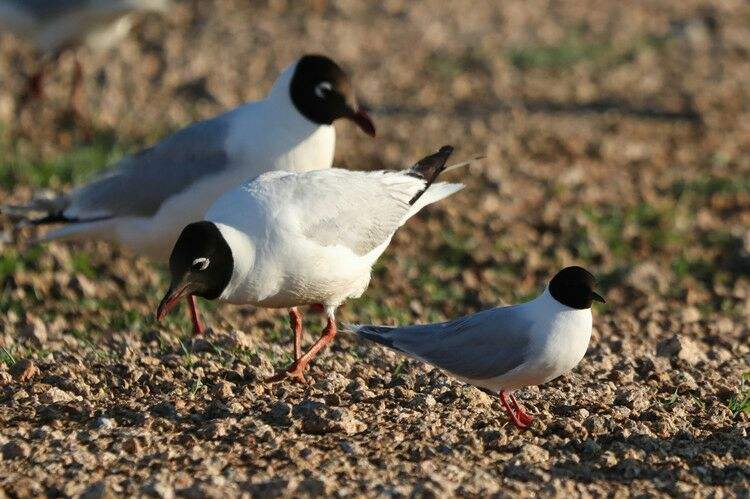Larus minutus
IUCN
LCBasic Information
Scientific classification
- name:Larus minutus
- Scientific Name:Larus minutus,Little Gull,Hydrocoloeus minutus
- Outline:Waterfowl
- Family:Lariformes Laridae Gull
Vital signs
- length:28.7-31cm
- Weight:108-150g
- lifetime:25 years or so
Feature
Summer feather head black, winter feather head white
Distribution and Habitat
Native species distribution: Albania, Algeria, Austria, Azerbaijan, Belarus, Belgium, Bosnia and Herzegovina, Bulgaria, Canada, China, Colombia, Croatia, Cyprus, Czech Republic, Denmark, Egypt, Estonia, Finland, France, Germany, Gibraltar, Greece, Guinea-Bissau, Hungary, Iran, Ireland, Israel, Italy, Kazakhstan Tanzania, Kyrgyzstan, Latvia, Lebanon, Libya, Lithuania, Macedonia, Malta, Mauritania, Mexico, Mongolia, Montenegro, Morocco, Netherlands, Norway, Poland, Portugal, Romania, Russia, Serbia, Slovakia, Slovenia, Spain, Sweden, Switzerland, Syria, Tunisia, Turkey, Turkmenistan, Ukraine, United Kingdom, United States, Uzbekistan.
Distribution of lost birds: Afghanistan, Angola, Bahrain, Barbados, Bermuda, Cameroon, Faroe Islands, Gabon, Gambia, Ghana, Greenland, Iceland, India, Iraq, Japan, Jordan, Kenya, Kuwait, Liechtenstein, Luxembourg, Nigeria, Puerto Rico, Saint Pierre and Miquron Islands, Saudi Arabia, Senegal, Sierra Leone, Sudan, United Arab Emirates Chief.
Origin unkn
Appearance
The head of the summer feather is black, and the back neck, waist, tail cover and tail are white, and the tail is slightly stained with gray. Back, shoulder, upper wing cover and the upper surface of the fly feathers are light pearl gray, the tip of the fly feathers is white without black, and the lower body is white with a slight rose color. The lower surface of the wings is black, and the tips and posterior margins of the wings are white.
The head of the winter feather is white, the top of the head and the pillow have a black spot, and the rest are like summer feathers.
Juveniles resemble non-breeding feathers, with a white forehead, black on the back and pillow of the head, pale gray to grayish-brown back, and white underbody. The tail is white, with broad black end spots.
The iris is dark brown, the beak is thin and dark red, the feet are red, the beak is dark brown, and the feet are red.
Size measurement: weight 108~150 grams; The body length is 287~305 mm, ♀290~310 mm
Details
Little Gull is a small waterfowl with no subspecies.

Little gulls are partly summer birds, partly travellers. Often move in groups. It spends most of its time flying above the water. Flying light, agile, flapping very lightly on the wings. It feeds mainly on spineless movers such as insects, insect larvae, crustaceans and mollusks. Foraging is mainly on the water, but also in flight to hunt flying insects, and sometimes on land.
The little gull's call is a series of loud, nasal kep, repeated over and over again. To show off the sound of ke-KAY, ke-KAY, ke-KAY at the same time both wings as hard as down.
Little gulls breed from May to June. They often breed in large groups, and sometimes mix with other gulls such as floating gulls. They usually nest on lakes, riverbanks, and nearby swamps where there are aquatic plants. The nest is mainly composed of dead grass, reed stems and leaves.
There are usually 2 to 3 eggs per litter, but there are as many as 4 to 5 eggs. The eggs are brown or olive green, with brown spots, and the size of the eggs is 37~46 mm x 26~32 mm. After the first egg is laid, the eggs are incubated, and the male and female birds take turns to bear the burden.
The global population of little gull is about 97,000 to 270,000 individuals (Wetlands International 2006). Population estimates by country are as follows: In China, there are about 100 to 10,000 breeding pairs and 50 to 1,000 travellers; Russia has about 100 to 10,000 breeding pairs and 50 to 1,000 travellers (Brazil 2009).
Listed on The IUCN Red List of Threatened Species: Not Threatened (LC), 2012 assessment.
Listed in China's "National Key Protected Wildlife List" (February 5, 2021) Level 2.
Protect wild animals and eliminate wild meat.
Maintaining ecological balance is everyone's responsibility!








